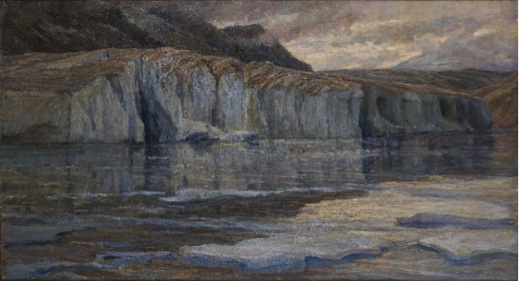
Le gelide acque del lago di Marjelen, 1908. Carlo Cressini
Ai margini dell’Aletsch, il ghiacciaio più esteso delle Alpi
La crisi climatica ormai più che acclarata non può che portarci a leggere questo paesaggio iconico con un sotteso interrogativo: che ne è oggi di quel ghiacciaio?
Ebbene di questa porzione di “seraccata” laterale dell’Aletsch, il ghiacciaio più esteso delle Alpi con oltre 120 km2 di superficie, che delimitava il Märjelensee ad occidente, alimentandolo delle sue acque di fusione, non rimane alcunché, essendosi il limite altimetrico dell’accumulo del ghiacciaio abbassatosi, per effetto dell’ablazione, dalla quota dei 2301 metri del laghetto ai poco più dei 2250 metri dell’attuale linea di equilibrio glaciale. Il Märjelensee assurge così, nell’intervallo di oltre un secolo trascorso dall’esecuzione dell’opera di Carlo Cressini, alla tipologia dei laghetti glaciali intramorenici, privo della sua “crepacciata” che l’aveva generato, contenuto solo da materiali morenici e rocce esposte.
Per stare nel nostro territorio è la stessa evoluzione che si è potuta vedere nel tempo con il fronte del ghiacciaio dell’Arbola un tempo immerso nelle acque del lago dei Sabbioni, ma via via ritiratosi lungo le pendici orientali della cima d’Arbola.
The Icy Waters of Lake Marjelen, 1908. Carlo Cressini
On the Edges of Aletsch, the Largest Glacier in the Alps
The now more than evident climate crisis can only lead us to observe this iconic landscape with an underlying question: What has that glacier become today?
Well, nothing remains of this portion of the lateral "icefall" of the Aletsch, the largest glacier in the Alps with over 120 km2 of surface area, which delimited the Märjelensee to the west, feeding it with its meltwater, as the altimetric limit of the accumulation of the glacier has decreased, as a result of the ablation, from the lake's altitude of 2301 metres to just over 2250 metres of the current glacial equilibrium line altitude. The Märjelensee thus rises, in the interval of more than a century that has passed since Carlo Cressini created this painting, to the typology of intra-morainic glacial lakes, devoid of the "crevasse" that had generated it, contained only by moraine materials and exposed rock.
To stay in our area, the same evolution has been seen over time with the front of the Arbola glacier that was once immersed in the waters of Lake Sabbioni, but gradually retreated along the eastern slopes of the Arbola peak.

